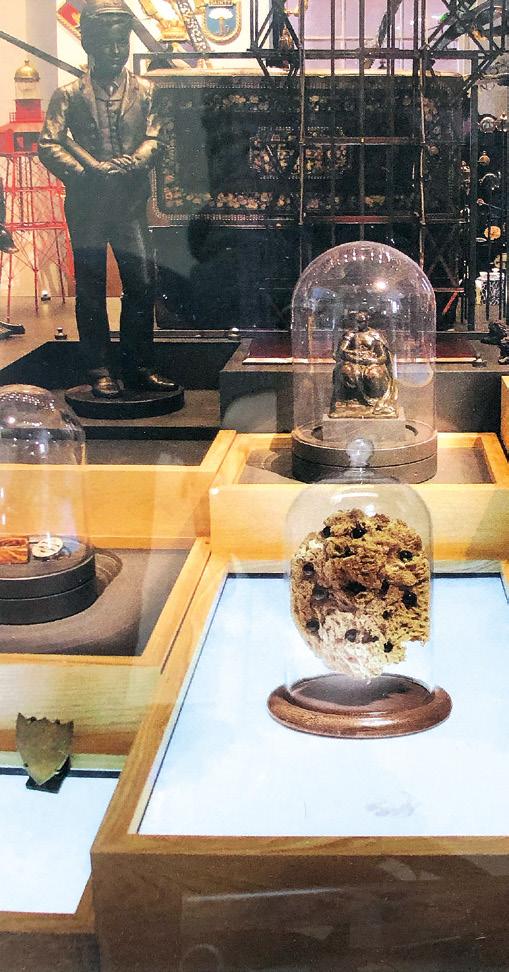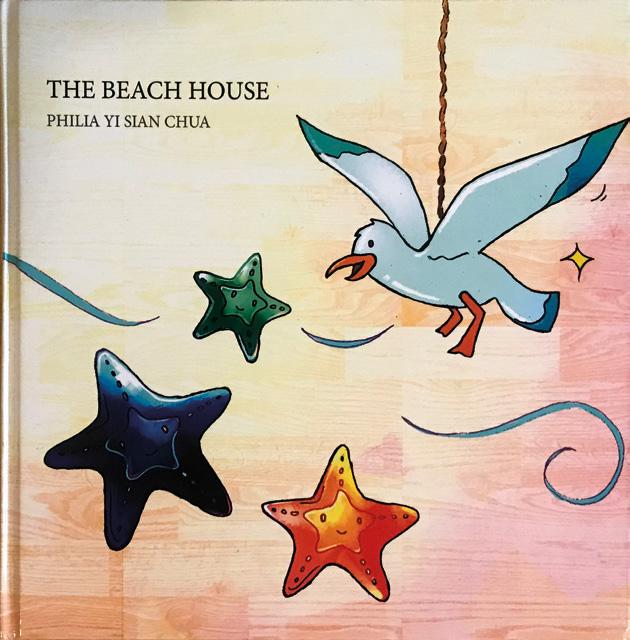
9 minute read
Design + Architectural Thesis
MArch ARCHITECTURE
Advertisement
CAROLINE RABOURDIN + MIKE ALING
Thesis Supervisors: Mike Aling, John Bell, Nicholas Boyarsky, Simon Herron, Rahesh Ram, Emmanuel Vercruysse, Simon Withers.
With thanks to our Thesis critics: Murray Fraser, Anne Hultzsch, Stephen Kennedy, Maria Korolkova, Caroline Rabourdin, Ed Wall, Tim Waterman.
THEORIES OF ARCHITECTURAL DESIGN
Theories of Architectural Design is a module that offers Year 1 students the opportunity to independently define and critically appraise ideas in relation to their own design projects and to the work of others. The module supports a deeper understanding of the design projects undertaken in the studio through critical reflection and argumentation. Students focus on topical themes from architectural discourse and produce an essay on an individually agreed topic that is developed through an intensive series of lectures and seminars running from the start of the academic year to the end of the first term. The module encourages students to make critical reflections on their own practice in relation to the wider context of contemporary architectural design, theory, the fine arts, technology and the human sciences. Students enhance their skills in research and writing, whilst further refining their critical awareness of the role of architectural theory in the field of architecture.
ARCHITECTURAL THESIS
The Architectural Thesis module allows every Year 2 full-time, and Year 3 part-time, student in MArch Architecture to develop a highly tailored piece of research to support the intellectual and/or technical ambitions of their final design project. The thesis can take many forms, be it an individually written historical, theoretical, technological or futurological essay, evidence based experimental and/or empirical technical research, work developed through specialist programming and scripting, experimental writing practices, interactive media, full size installations and constructions, and performance-based research, amongst other forms of research practice relevant to the particular interests of the individual student. Each student works with an individual Thesis supervisor to develop the exact content and structure of the final output.
Concurrent to the Thesis, students also develop a Research Methods Statement (RMS), a 1000-word submission that demonstrates a systematic understanding of different relevant research methods and knowledge of the correct implementation of different research methodologies in the production of the Thesis. The RMS is initiated through an intensive series of lectures that run at the start of the academic year.
Students identify, investigate and communicate in detail a specific topic of architectural research, demonstrating skills in evidence-based research and writing. The Thesis offers students the opportunity to develop a rigorous intellectual position that informs, and symbiotically synthesizes with, the major Design Project undertaken in the studio. The Thesis supports design practice with a highly informed knowledge base and critical engagement with the relevant technical, historical and/or theoretical issues at the forefront of the architectural discipline. The Thesis encourages highly creative, critical, inventive and innovative forms of research.
Abstracts from a range of our highest achieving theses in 2019-20 can be found on the following pages.
→ Qiuyu Jiang
How to Design a Home that Loves you Back?
A Study of Relationships Between Objects,
Homes, Technologies and Humans
Supervisor: Rahesh Ram
Anna Helliar
Is ‘Pataphysics Useful? Narratives and Wicked Problems Supervisor: John Bell
An academic of sound mind would laugh at the prospect of attempting to harness ‘pataphysics in any form. To define it is to make a mistake. ‘Pataphysics conception is primarily linked to Alfred Jarry, a French poet who developed a contrasting science to metaphysics by exploring anomalies not yet explained. Referred to as an avant-garde pseudoscience, the language of ‘pataphysics does not rely on the stark contrast of right and wrong, real and unreal. Instead, it focuses on narrative, described by Jarry as “the science of imaginary solutions.” Within our society, we have lost a primal connection to our natural surroundings, and we are ignoring the multitude of warning signs that our planet is giving us. As a species we look for new ontological narratives that can aid us in reconnecting with nature. Questioning the agency that ‘pataphysics holds, the thesis is constructed as an exhibition that explores a multitude of effects. Through an engagement with abstract thinking encouraged by ‘pataphysics, the thesis restructures the ‘wicked problem’ of the climate crisis through the use of the five core ‘pataphysical elements; clinamen, syzygy, anomaly, opposite and antinomy.
Bethany Hird
Carbon Offsetting Las Vegas: A Study on Remedial Design Supervisor: Simon Herron
In 2015 the United Nations Framework Conservation on Climate Change negotiated an agreement for dealing with greenhouse gas emissions, mitigation, adaptation and finance (Sutter, 2015). This agreement outlined the goal to keep the increase in global average temperature to under 2⁰c in relation to pre-industrial temperatures, and pursue the goal to limit temperature increase to 1.5⁰c. This figure is said to sustainably reduce the risks and impact of climate change on the environment. By November 2019, all 188 UNFCCC members had signed the agreement, requiring each country to determine a plan and regulatory report on the contribution they undertake to mitigate global warming. In the press, carbon emissions are a popular topic, and new methods of carbon offsetting are often discussed, however the viability and legitimacy of said offsets remain unclear. In the beginning, phoney ‘carbon offset schemes’ were more common than not (Azlen, 2019), and whilst standards and regulations have improved, the way that carbon emissions are calculated and declared, and the legislation behind this, is as unclear as ever. This begs the question of accuracy, legitimacy and credibility regarding emission and offset data, suggesting that the problem may be worse than it appears, and carbon offsetting may be a mechanism of greenwashing.


← Anna Helliar 'Phylum & Swords' and 'Balaena 2519' from a series of exhibits across London ↓ Bethany Hird
Carbon offsetting the total emissions produced in the making of the thesis

Luis Rojas Paipilla
Ayawashka: Nature, Being and Entheogenic Architecture Supervisor: Mike Aling
This thesis explores the indigenous epistemologies of tribes in the Amazon rainforest, discussed through an engagement with the contemporary discourses of posthumanism and panpsychism. The thesis aims to expand on the current redefinition of the notion of the human, and the need for architecture to be designed towards a praxis of coexistence with nature and other earthly beings. Ayawáskha is a hallucinogenic ‘brew’ consumed in a ritual by the Tukanos and Shipibo people in the Amazon, ingested to expand an understanding of their ecology and their role within it. Guided by a Taita (shaman), the ceremony takes the participant through stages of self-recognition, repentance, determination to change, purging and ecstasy, whilst both physically and psychologically ‘cleaning’ the participant in order to trigger visions that fully enmesh the participant with their surrounding natural environment. The thesis reconstructs the space of the Maloka, the indigenous hut, as a virtual reality experience, and critically examines the ‘psychotropic practicing’ of its architecture. The study redefines the stages of the ritual as a set of parameters that speculates on how architecture more generally can enhance its relationship with natural contexts.
Meriel Serlin
J.D. Wetherspoons: The Public House as Civic Architecture Supervisor: Simon Withers
This thesis is an evidence-based enquiry into adapting architecture for civic roles, through the lens of the pub chain JD Wetherspoon. It seeks to identify how Wetherspoons have successfully created their own architectural typology of pub that becomes civic in its function, through a critical analysis of the history and evolution of the public house. The thesis discusses what constitutes the ‘public house’, with ideas on who forms the ‘public’, public space and its changing nature to ‘quasi’ public space, and the extent to which Wetherspoons responds as a civic space. This thesis concentrates on the ‘traditional’ pub in England and Wales, since Scottish and Irish pubs have a different history through their independent laws and licensing. An analysis of Wetherspoons’ position is made through first hand visits to specific branches of the chain. It focuses mainly, but not exclusively, on the urban Wetherspoons as loneliness, isolation, anxiety and deprivation are highest in cities. The focus is not the community value of the rural pub, but rather how Wetherspoons’ have created and promoted an adaptable prototype that can be viewed as a civic pillar nationwide.



← Luis Rojas Paipilla
Realtime journey through the Maloka in VR ↙ ↓ Meriel Serlin
Thesis form as Wetherspoon News

Philia Yi Sian Chua
Gaia Stories and Speculative Fabulations for a Multispecies Flourishing Future Supervisor: Rahesh Ram
This thesis seeks to critically evaluate our broken relationship with nature and uncover the power of storytelling to reconfigure this relationship. Gaia stories and speculative fabulations—called forth by Donna Haraway and other leading figures in the field—embody the ability to initiate different modes of thinking and relating to our natural world. Upon establishing our current anthropocentric context to reveal the urgent need for us to change our story, a study on the effects, impacts and limitations of storytelling are discussed. This is followed by case studies and analyses on various storytelling mediums and techniques as well as investigating provocative design practices that enable these stories to permeate into architecture. Architecture—as an integral mediator between humans and nature—needs new storytelling practices to transform the way that we position ourselves in this world, disclosing the message that we are a part of Gaia, to live-with and become-with Gaia for a multispecies flourishing future.
Luisa-Marie Sommerer
The Constructed Illusion of a European Town in Yuanming Yuan: Western-Chinese Fantastical Imaginings Supervisor: Nicholas Boyarsky
This thesis establishes how, through a rare example of eighteenth century cross-cultural collaboration between the multidisciplinary team of Italian Jesuit painter Guiseppe Castiglione and the Chinese Yangshi Lei architecture family, a Western-Chinese drawing perspective was developed. This was utilised in the open-air theatre scenography in the Gardens of Yuanming Yuan, depicting a fantastical Européenerie town. The thesis analyses the epistemological inaccuracies between the Western manual on perspective and scenography, Perspective et Pictorum et Architectorum by Andrea Pozzo, and its Chinese part-translation, the Shi Xue. Extensive scholarship by Art Historian Kristina Kleughten establishes discrepancies between the Western and Chinese manuals and draws connections between the Shi Xue and the illusion of a European town. Through 3d reconstructions, experiments, comparison studies and testing the findings against Italian Renaissance theatre principles, this thesis interrogates how the inaccuracies of the Shi Xue layout would have impacted the usability of the stage. Edward Said’s discourse on unilateral Orientalism is consequently critiqued, and through virtual reconstructions the thesis argues that these architectural inaccuracies were not a form of epistemological mistranslation, but a creative trigger for cross-cultural drawing techniques forged by a trans-cultural design team.


← Philia Yi Sian Chua
The Beach House, from the Gaia
Stories series ↓ Luisa-Marie Sommerer
Emperor Qianlong's view overlooking the European Town in Yuanming Yuan










